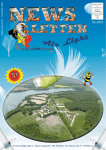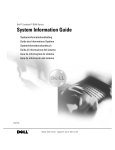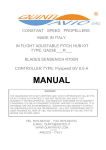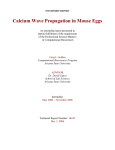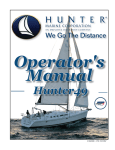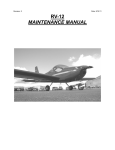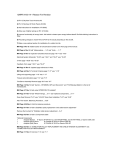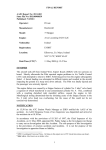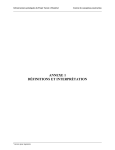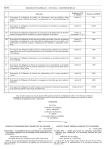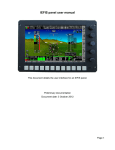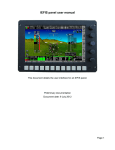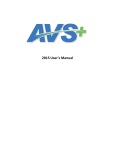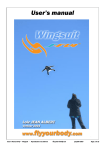Download FINAL REPORT ON THE ACCIDENT TO ASSO AEREI
Transcript
AAIU-2010-34 Air Accident Investigation Unit - (Belgium) CCN Rue du Progrès 80 Bte 5 1030 Brussels FINAL REPORT ON THE ACCIDENT TO ASSO AEREI CHAMPION V UL260i REGISTERED OO-G08 AT EBZH ON JULY 4, 2010. Ref. AAIU-2010-34 Issue date: 22 March 2011 Status: FINAL AAIU-2010-34 FOREWORD ................................................................................... 3 SYNOPSIS ...................................................................................... 4 1. FACTUAL INFORMATION ........................................................... 5 1.1. History of flight ............................................................... 5 1.2. Injuries persons ............................................................. 6 1.3. Damage to aircraft ......................................................... 6 1.4. Other damage ................................................................ 6 1.5. Personnel information .................................................... 6 1.6. Aircraft information ......................................................... 8 1.7. Meteorological conditions. ........................................... 20 1.8. Aids to navigation. ....................................................... 20 1.9. Communication. ........................................................... 20 1.10. Aerodrome information. ............................................ 20 1.11. Flight recorders. ....................................................... 21 1.12. Wreckage and impact information. ........................... 22 1.13. Medical and pathological information. ...................... 23 1.14. Fire ........................................................................... 23 1.15. Survival aspects ....................................................... 23 1.16. Tests and research. ................................................. 23 1.17. Organizational and management information. .......... 24 1.18. Additional information. .............................................. 24 1.19. Useful or effective investigation techniques. ............ 24 2. ANALYSIS. ............................................................................ 25 2.1. Engine failure ............................................................... 25 2.2. Pilot’s reaction after the engine failure ......................... 36 2.3. Weight and Balance ..................................................... 37 3. CONCLUSIONS ...................................................................... 38 3.1. Findings. ...................................................................... 38 3.2. Causes......................................................................... 38 3.3. Contributing factors ...................................................... 39 4. SAFETY RECOMMENDATIONS. ................................................. 40 4.1. Recommendation 2011-U-1 ......................................... 40 4.2. Recommendation 2011-U-2 ......................................... 40 4.3. Recommendation 2011-U-3 ......................................... 40 4.4. Recommendation 2011-U-4 ......................................... 40 4.5. Recommendation 2011-U-5 ......................................... 40 22 March 2011 2 AAIU-2010-34 FOREWORD This report is a technical document that reflects the views of the investigation team on the circumstances that led to the accident. In accordance with Annex 13 of the Convention on International Civil Aviation, it is not the purpose of aircraft accident investigation to apportion blame or liability. The sole objective of the investigation and the Final Report is the determination of the causes, and define recommendations in order to prevent future accidents and incidents. In particular, Article 13 of the Royal Decree of 9 December 1998 stipulates that the safety recommendations made in this report do not constitute any suspicion of guilt or responsibility in the accident. Unless otherwise indicated, recommendations in this report are addressed to the Regulatory Authorities of the State having responsibility for the matters with which the recommendation is concerned. It is for those Authorities to decide what action is taken. The investigation was conducted by H. Metillon. NOTE: For the purpose of this report, time will be indicated in UTC, unless otherwise specified. 22 March 2011 3 AAIU-2010-34 Synopsis Date and hour of the accident Sunday July 4, 2010 at 16:45 UTC Airplane ASSO CHAMPION V UL-260i, registered OO-G08 Accident location EBZH airfield. Airplane owner C.I.K. B.V.B.A. Type of flight Training Persons on board 2 Narrative: On Sunday 4 July, the pilot wanted to perform a flight with the Asso Champion V OO-G08. He asked an Instructor to fly along. For the purpose of this report, we assume the pilot to be seated on the LH seat while the instructor was seated on the RH seat. Witnesses reported the take-off preparation, with engine power-up as being normal. After a normal take-off run with flaps up, the airplane took-off. Witnesses reported that they heard the engine stopping abruptly when the airplane was about 2/3 of the length of the runway. They saw the airplane leveling, then slightly turning to the right, then to the left, shortly followed by a stall of the LH wing. The airplane crashed against the earth bank bordering the airfield, 15m before the end of the runway. The occupants died upon impact. The airframe caught fire and was totally destroyed. 22 March 2011 4 AAIU-2010-34 1. Factual information 1.1. History of flight On Sunday 4 July, the pilot wanted to perform a flight with the Asso Champion V OO-G08. Owing to his low experience on this airplane, he asked an Instructor to fly along. He had flown the airplane only once before, on June 06, 2010. This flight, with the same instructor, ended in a wheels up landing on the same airfield. At 16:04 UTC, they logged the flight in the airfield log book, and went to prepare the airplane. The airplane was pushed out of the hangar, and the engine was tested for approximately 15 minutes, according to witnesses. Later, the airplane was taxied for refueling and after the refueling taxied again for take-off the Runway 27 of EBZH. Witnesses reported the take-off preparation, with engine power-up as being normal. After a normal take-off run with flaps up, the airplane took-off. When alongside the clubhouse, it was seen at an altitude of 15-20m, climbing (―hanging on its engine‖, according to a witness). The airplane waggled somewhat due to the wind. Witnesses reported that a few seconds later they heard the engine stopping abruptly. They saw the airplane leveling, then slightly turning to the left shortly followed by a stall of the LH wing. Another witness reported later that he saw the airplane leveling off and making a right hand turn immediately followed by a slight left hand turn. Then, he saw as the other witnesses the airplane making a left hand wing stall. 22 March 2011 5 AAIU-2010-34 The airplane impacted the ground perpendicularly to the flight direction, LH wing first. The airplane crashed against the earth bank bordering the airfield, 15m before the end of the runway. The airplane caught fire rapidly, and the wreckage was caught in a sea of fire, consuming the whole aircraft, with the exception of the metallic parts. The occupants died instantly. 1.2. Injuries persons Injuries Fatal Serious Minor None Total Pilot 2 0 0 0 2 Passenger 0 0 0 0 0 Others 0 0 0 0 0 Total 2 0 0 0 2 1.3. Damage to aircraft The airplane was totally destroyed 1.4. Other damage The grass was burned. 1.5. Personnel information Pilot: Sex: Age: Nationality: Licence: 22 March 2011 Male 53 years old Belgian Belgian Ultra Light Pilot Training Licence Issued on December 21, 2005. Belgian Ultra Light Pilot Licence First issued on May 07, 2008. Last issued on November 26, 2009. Valid until November 25, 2010. 6 AAIU-2010-34 Ratings: ULM Class rating. Skill test: Proficiency Check passed on September 27, 2009 for the renewal of the licence. Medical Certificate: Class 3, valid until November 25, 2010. Flight experience: Instructor pilot: Sex: Age: Nationality: Licence: The pilot had on November 23, 2009 a total flight experience of 82 FH including 50 FH as pilot in command. The total flight experience of the pilot at the date of the accident is assumed to be about 100 FH. He flew only once in double controls for 1 FH on OO-G08 with the same pilot instructor. This flight was performed on June 6, 2010 and ended with a gear up landing. Male 59 years old Belgian Ultra light: Belgian Ultra Light Pilot Licence First issued on April 24, 1989. Last issued on March 02, 2010. Valid until February 13, 2011. Single Engine Piston: Belgian Private Pilot National (PPL) Licence Issued on March 02, 2000. JAA/ PPL(A) Licence First issued on February 02, 2006 Last issued on March 12, 2010 Valid until February 14, 2011. Ratings: 22 March 2011 Ultra light: Class Rating: ULM. Ultra light monitor since July 2, 1996. Skill test: Proficiency Check for Ultra light Monitor rating passed on September 9, 2008. Valid until Augustus 31, 2011. 7 AAIU-2010-34 Single Engine Piston: SEP (land). Skill test: Proficiency Check passed on March 05, 2010. Valid until March 31, 2012. Other rating: English valid until February 14, 2011. Medical Certificate: Class 2, valid until February 13, 2011. Flight experience: On February 12, 2006 the pilot had 1.112 FH of Ultra Light flight experience and 342 FH experience on Single Engine Piston aircraft. The total flight experience of the pilot at the date of the accident is around 1250 FH on Ultra Light aircraft and 500 FH on Single Engine Piston aircraft. The flight experience on OO-G08 was limited to 5 FH. 1.6. Aircraft information Airplane general information The ASSO AEREI Champion V is an Ultra Light Airplane home built of Italian design. It was delivered as a kit to customers. This airplane had the following characteristics: three axis low wing airplane equipped with two-seats side by side, electrical flaps, a tricycle, electrically retractable landing gear and a fixed pitch propeller, adjustable on the ground. The fuel was contained in a tank made of aluminium with a capacity of 60 litres. This fuel tank was installed behind the firewall. The airframe was essentially built of wood and fabric. The prototype of ASSO AEREI Champion V flew in 1995 and reportedly; the factory sold around 40 kits before the production stopped. The OO-G08 had serial number 40 and was supposed to be the last airplane produced. 22 March 2011 8 AAIU-2010-34 The airplane was assembled by a small Belgian company called ―CAPCO AVIATION‖ that used the most complete kit called ―Fast Kit N°3‖. This kit was composed of a complete and ready aircraft, cover and fabric coated. It was ready to accept engine unit, instruments, cabin interior optional and finish paint. During the build up of the airplane a major change was introduced by installing a ―ULPOWER‖ engine instead of one of the engine suggested by ―ASSO AEREI‖. This modification was accepted by the Belgian CAA on September 03, 2008. The airplane was provided with a specific ―Flight and maintenance Manual‖ reference ―CAPCO- AVIATION ASSO V UL260i‖ OO-G08 was flown for the first time on August 28, 2008. 22 March 2011 9 AAIU-2010-34 General Characteristics: Crew: Capacity: Length: Wingspan: Height: Wing area: Empty weight: Max takeoff weight: 1 2 occupants 6,09 m 8,15 m 2,13 m 11,00 m2 280,95 kg 450,00 kg Airframe: Manufacturer: Type: Serial number: Built year: Registration: Total flight hours: ASSO AEREI CHAMPION V UL260i 40 2008 OO-G08 78:24 FH Engine: Manufacturer: Type: Serial number: Total flight hours: ULPOWER UL260i 06 78:24FH 22 March 2011 10 AAIU-2010-34 Propeller: Manufacturer: Type: Serial number: Total flight hours: SENSENICH 2AOJ5R64ZN Unknown 0:30 FH Owner: Company ―C.I.K. BVBA‖ Certificate of registration: Number 6601.Original issue dated August 20, 2008 Certificate of airworthiness: Restricted Authorization for ULM issued on September 26, 2008 Engine description: The ULPOWER is a 4 stroke air cooled gasoline engine, with 4 horizontally opposed cylinders, with direct propeller drive. It delivers a power of 97 hp @ 3300 rpm and 85 hp @ 2800 rpm. The engine is equipped with an electronic injection and ignition system. The fuel and the ignition systems are both managed by the ―Engine Control Unit‖ (ECU).It was decided to install the ECU of OO-G08 on the engine side of the firewall due to the lack of space between the fuel tank and the rear 22 March 2011 11 AAIU-2010-34 side of the fire wall. The cooling of the ECU was made by a fresh air flow coming from a LH engine cowling NACA air intake. ULPOWER Engine electrical / electronic schematic diagram 22 March 2011 12 AAIU-2010-34 RPM and Throttle Position are the main inputs to the ECU. Three primary sensors are necessary to make the engine run: ―Throttle position sensor‖, ―Hall sensor sync‖ and ―Hall sensor speed‖. The air intake manifold valve is manually controlled by the pilot. Each position of the manifold valve is automatically detected by the Throttle Position Sensor (TPS) and transmitted to the ECU. The pre-programmed fuel map in the ECU regulates the amount of fuel that is injected through the injectors and the pre-programmed advance map determines ignition timing. The fuel system requires fuel pressure from an external electrical fuel pump to work. The fuel is fed to the engine by an electrical fuel pump located on the firewall. The pump normally delivers a relative fuel pressure of 3 bar (With a maximum of 3.8 bar and a minimum of 2.4 bar). On OO-G08 an optional relay switch was placed between the pump and Engine Control Unit (ECU), allowing the ECU to determine automatically when the pump should start and stop. Once power is supplied to the ECU it will start the pump to build up pressure for about 1.5 seconds, after which it will shut down the pump until the pilot engages the starter. Once the ECU detects the engine is turning, it switches on the pump to provide fuel and leaves it on until it detects that the engine has been stopped. A second optional electrical fuel pump was also installed as a backup. According to the engine manufacturer, this pump should only be switched on manually for short periods (e.g. take-off) and in case of an emergency in the event that the main pump had failed. The engine manufacturer says that experience has shown that leaving both pumps running simultaneously would cause one of the pumps to overheat due to insufficient fuel flow through the pump. This can result in a pump failure, eliminating backup if or when it is needed. (Reference ULPOWER Installation manual R3 page 17). 22 March 2011 13 AAIU-2010-34 The use of the backup pump during critical flight stages (e.g. take-off) was not foreseen by the OO-G08 ―ASSO Champion V260i Flight Manual‖ in the § 4 ―Normal Procedure‖. This Flight manual prescribes the activation of the backup pump only in the § 5 ―Emergency Procedure‖: Switch over to the emergency fuel pump in case of engine failure above 820 Ft. This restricted use of the backup fuel pump, as mentioned in the Flight manual, was confirmed by ―CAPCO AVIATION‖ after the crash. As controlled by the ECU the ignition coils convert the incoming current of the alternator or battery into a high voltage to generate a spark in the spark plugs. Each cylinder is provided with 2 spark plugs and each spark plug of the same cylinder receives its high voltage from two different coils. Since the engine is electronically controlled by the ECU and a current is needed to generate the sparks and operate the fuel pump, the engine cannot run without a functioning electrical system. The electrical energy is provided by a battery and/or an integrated AC generator from which the alternating current is managed and rectified into direct current by an external rectifier-regulator. The battery is used to start the engine and to drive the electrical fuel pump. Once the engine is started, the alternator delivers enough energy to feed the ECU and the electrical fuel pump. The integrated AC generator can supply up to 35 Amps at 3300 RPM and about 29 Amp at 2800 RPM, corresponding to the maximum cruising speed RPM of the airplane. At 900 RPM an excess of 7 Amp is available to charge the battery and/or feed the airplane accessories. At 1500 RPM an excess of 13 Amp is available. That means that the energy needed to start the engine is rapidly restored to the battery by the alternator during the warm up and the taxi of the airplane. 22 March 2011 14 AAIU-2010-34 A load test of the electrical system was done at the end of the airplane construction. All the accessories were set ON, first with the airplane on jacks to allow the test of the landing gear but without the engine and the fuel pump. Then with the airplane on the ground with all the accessories ON and with a running engine but without a test of the landing gear. In addition to the second ―backup‖ fuel pump, ULPOWER provides five optional possibilities of ECU redundancy as follows: An optional capacitor that allows the engine to run in case of battery failure, A second ECU equipped with its own set of Hall Sensors, A second ECU equipped with its own set of Hall Sensors and a second battery, A additional controller without software A additional controller without software and a second battery None of the backup systems, except the optional capacitor, feature automatic switching from the main system to the backup system implying that the pilot has first to identify the problem before being able to manually switch on the redundancy system. ULPOWER Engine Safety information (Selected extracts) As for most engine types used on Ultra lights, the absence of regulatory requirements implies the introduction of precautionary notes in the user’s manual. The following safety information’s can be found in different ULPOWER publications: This non-certified engine is designed for possible application on aircraft used in VFR conditions which have the capabilities of controlled gliding without engine power. You should be aware that any engine may seize or stall at any time. This could lead to a crash landing and possible severe injury or death. For this reason, we recommend strict compliance with the maintenance and operation and any additional information which may be given to you by your dealer. 22 March 2011 15 AAIU-2010-34 Never fly the aircraft equipped with this engine at locations, airspeeds, altitudes, or other circumstances from which a successful no-power landing cannot be made, after sudden engine stoppage. The ECU (Engine Control Unit) used for the ULPOWER engine has been specially developed, and thoroughly tested. Every possible "overvoltage" or short-circuit has been simulated to be sure that the ECU goes on working in every condition. ULPOWER has about 15 years experience with this ECU for other applications without any failure. The ECU deserves a lot of trust. Time has proven that these units are reliable and well shielded from electronic and magnetic radiation. However, for extreme safety, we offer a completely redundant, dual channel ECU combination. (5 possibilities are available). Mount the ECU unit in a place where temperatures do not reach over 65°C (preferably on the cabin side of the firewall). Even though electrical fuel pumps are very reliable, many pilots prefer the security of a back-up fuel pump in case of sudden failure of the primary fuel pump. To check that it is operating properly, the reserve pump is switched on (before the ECU is switched on in the case where it commands the primary fuel pump) to check that sufficient fuel pressure can be built up. It is not advisable to let both electric fuel pumps run continually as in almost all circumstances only the first pump which is switched on will actually have fuel flowing through its rotor no matter whether the engine is operating or not. This is because the fuel pumps have a non-return or check valve on the pressure side of the pump. (Reference: FAQ web site of ULPOWER) 22 March 2011 16 AAIU-2010-34 OO-G08 Electrical Schematic Diagram 1 Alternator fuse 2 Alternator fuse 2 Alternator fuse 3 Regulator / Rectifier fuse 4 Battery fuse 5 Master relay 22 March 2011 7 Bus bar circuit breaker 8 Starter push button 9 Starter relay 10 ECU Power switch 11 Aux Fuel pump switch 12 Smoke shed switch 17 AAIU-2010-34 Based on the airplane manufacturer (CAPCO AVIATION) we determined the electrical consumption of the various equipments Electrical Component Flaps motor Landing Gear motor Trim motor (Ray Alen) Landing light Transponder (Micro-Air) Radio (Filser ATR 500) Minimum Maximum Remarks Consumption Consumption (Amps) (Amps) 6 4 Including buzzer and Warning lights 0,075 0,150 0,700 0,200 0,150 1,80 GPS (Garmin Pilot III) Instruments VDO Tach&Hour VDO Fuel Level VDO Fuel Press VDO Voltmeter Warning Light Engine including main fuel pump and 2nd Ignition system Back up fuel pump 22 March 2011 0,045 9 Single led Alticoder included Max current during transmission Portable GPS fed though the cigar lighter 0,1 0,1 0,1 0,1 0,2 15 6 18 AAIU-2010-34 Flight manual procedure for takeoff (Page 13) Release the parking brake and taxi to the point of departure by testing the brakes. Close the canopy, position the flaps for takeoff (first notch 12°) Close the heating system. Progressively increase engine RPM Un stick the aircraft at a speed not under 90 km/h Maintain the engine at maximum RPM during the initial climb, then reduce the power and retract flaps Adjust the trim for climbing Retract the landing gear Flight manual check list for takeoff (Page 18) Close and lock the canopy Release parking brake One notch of flap Verify trim position Increase the engine RPM Un stick at 92 km/h While climbing, begin reducing engine power Flaps completely up Trim for climb angle Retract the landing gear Maintenance The maintenance and repair was done by the assembler of the airplane ―CAPCO AVIATION‖. Preventive maintenance and inspections were complied with at 15 FH and 50 FH. The following incidents, repair and modifications are reported: The 20 Amp fuse number 3 that was installed downstream of the ―Regulator Rectifier‖ blew during the first test flight. It was then decided to replace it by a 30 Amp fuse. At the same time, the three 20 Amp alternator fuses were also replaced by 30 amp fuses. 22 March 2011 19 AAIU-2010-34 The airplane performed a gear up landing on June 6, 2010 at 77:54 FH due to the non activation by the pilot of the landing gear control switch. The airplane was then inspected and repaired. A new propeller was installed and some minor damages were corrected including the repair of a crack on the nose landing gear. During the inspection and repair a ―Visual Warning Light‖ was added to the existing ―buzzer‖ landing gear warning. A satisfactory test flight was done on July 03, 2011. Finally, the above mentioned 30 Amp of the ―Regulator Rectifier‖ (that was initially 20A) was again replaced by a stronger 50 Amp fuse during the ―Landing Gear Up‖ repair. This change was introduced after ―CAPCO AVIATION‖ had been advised by ―ULPOWER‖ not to install a fuse at this place. 1.7. Meteorological conditions Wind direction: Wind speed: Temperature: Visibility: 270° 7 kt 28° More than 10 km 1.8. Aids to navigation Not applicable 1.9. Communication Reportedly there was normal communication established between Kiewit AFIS and OO-G08 for the taxi and take off information. 1.10. Aerodrome information The airfield of Kiewit EBZH is located 50°58'12"N 005°22'30"E, at 5 km north of the city of Hasselt (Belgium). The elevation is 141ft (43m) and it is equipped with a 600 m long – 18 m wide grass runway oriented 090° / 270°. Maximum strength is 5700 kg. 22 March 2011 20 AAIU-2010-34 The east and the south east of the airfield are bordered by an embankment, intended to reduce the noise of the airplanes for the neighborhood. The slope shows an elevation of 1.6m at the end of the runway and a shoulder of 2,00m high on its left side. The height of the embankment remains within acceptable ICAO (Annex 14) limits The runway 27 (Toward the city of Hasselt) is bordered by trees, houses, and irregular ground surfaces. This operator is ―Aeroclub Kiewit‖ and the use of the airfield is subject to prior permission from the operator. The circuits are left hand for runway 09 and right hand for runway 27, at an altitude of 1400 ft. The aerodrome is provided with a Flight Information Service (AFIS) called ―Hasselt Radio‖ on the frequency 118,325 MHz (Information only, no ATC). 1.11. Flight recorders Not applicable 22 March 2011 21 AAIU-2010-34 1.12. Wreckage and impact information The airplane impacted the ground perpendicularly to the flight direction, LH wing first. The airplane crashed in to the embankment bordering the airfield, 15 m before the end of the runway. The distribution of the remains of the airplane were oriented such that the engine and the nose of the airplane pointed in the opposite to the flight direction. The engine was lying upside down. The landing gear actuators were fully extended indicating that the landing gear was not retracted. The airplane first hit the ground with the left hand wing tip and rebounded up to rest against the 2,0m high shoulder side of the airfield. The first impact of the left hand wing tip was about 10m away from the final resting place. The second impact 5 m further was probably due to the nose landing gear. The wreckage was found parallel to the runway in the opposite direction of the take off. The airplane caught fire rapidly, and the wreckage was caught in a sea of fire, consuming the whole aircraft, with the exception of the heavy metallic parts. 22 March 2011 22 AAIU-2010-34 Examples of some remaining metallic parts: One main landing gear and the central section of the wing spars. 1.13. Medical and pathological information The occupants of the airplane died instantly from the impact. 1.14. Fire Fire broke out shortly after impact. The fuel tank probably ruptured by the shock, and fuel came in contact with the hot parts of the engine, causing ignition of the vaporized fuel. 1.15. Survival aspects The accident was not survivable. 1.16. Tests and research Not applicable. 22 March 2011 23 AAIU-2010-34 1.17. Organizational and management information Not applicable 1.18. Additional information None 1.19. Useful or effective investigation techniques Not applicable 22 March 2011 24 AAIU-2010-34 2. Analysis. 2.1. Engine failure Witnesses reported that they heard the engine stopping abruptly. This could have been caused by one of the following: 1. A mechanical failure of the engine. 2. An obstruction of the engine air intake. 3. A failure of the electrical supply to feed the ECU or the fuel pump. 4. A fuel shortage or a failure of the fuel system to properly feed the injection system. 5. A failure of the ECU or of one of its crucial accessories (loom, primary sensor …) 6. An inadvertent switching OFF of one of the engine control switches (Master switch, ECU switch …). 2.1.1. Mechanical failure of the engine The remains of the engine have been thoroughly inspected: There was no oil inside the case which is normal due to the upside down position of the engine after the crash and the burned oil filling tube. There was no sign of mechanical failure. There was no sign of metallic chips. The crankshaft was not jammed. The crankshaft was mechanically connected to the camshaft. The intake and exhaust valves were free to move. They were moving under the action of the camshaft. There was no sign of spark plug damage. The ―Hall sensor sync‖ and ―Hall sensor speed‖ plastic connectors were found burned at their respective normal position. The ends of the electrical wire of each connector were still attached to the burned connectors. There was no sign of mechanical failure that can explain the sudden engine stoppage. 22 March 2011 25 AAIU-2010-34 2.1.2. A sudden obstruction of the manifold air intake The induction manifold and throttle have been thoroughly inspected. Most of the non-metallic parts were burnt including the air filter. However, there were no sign of abnormalities. The throttle was yet free of movement, the end of the throttle cable was still attached to the throttle fitting and there was no sign of obstruction of the manifold. Witnesses reported the sudden stoppage of the engine. In the case of an air intake obstruction the engine would have sputtered, backfired and caused visual black smoke coming from the exhaust. None of these phenomenon were reported. No evidence was found to support the hypothesis of engine stopping due to the obstruction of the engine air intake. 2.1.3. A failure of the electrical source to feed the ECU and the fuel pump As the airplane was completely burnt, it was impossible to detect in the wreckage a possible defective electrical loom, connector, switch or fuse. We can only base our analysis on the electrical schematic diagram and on the history of the airplane. It is known that: The airplane was fitted with a 22 Amp battery, in use since August 2008. The 35 Amp engine driven alternator was able to deliver 29 Amps at 2800 RPM corresponding to max cruising speed. The 20 Amp fuse number 3 that was originally installed downstream of the ―Regulator Rectifier‖ blew during the first test flight. However, the battery worked as a back up and the engine did not stop running. The current flow at 22 March 2011 26 AAIU-2010-34 the moment the fuse number 3 blew was almost entirely used to feed the bus bar, as the battery was completely charged before the take off. The total of the airplane and engine current, except the starter current, passed through the ―Master Switch Relay‖ and the 30 Amp bus bar fuse (number 7). The ―Master Switch Relay‖ was controlled by the pilot through the activation of the ―Master Switch‖. For information, the EASA CS-23.1357 Regulation, used for Normal, utility, aerobatic and Commuter Aeroplanes but not for Ultra lights states: “A protective device for a circuit essential to flight safety may not be used to protect any other circuit”. The engine ECU and the fuel pump needed 15 amp to run. The starting current of all electrical motors shows an undetermined peak when it starts. This current being automatically reduced as soon as the motor turns. The battery was able to provide additional electrical energy when the alternator delivered current was not sufficient for the airplane consumption. That means that the available electrical current (alternator and battery together) was much higher than the 29 Amp of the alternator. Two different loading test of the electrical circuit were done at the end of the airplane construction. During the first test while the engine was not running, all the accessories were set ON and the different electrical motors such as those of the landing gear, the trim and the flaps were activated. As the 15 amp current required to make the engine run was not taken into account, this loading test did not represent the maximum possible current consumption of the airplane. During the second test while the airplane was standing on its landing gear and the engine was running, all the accessories were set ON and the different electrical 22 March 2011 27 AAIU-2010-34 motors such as those of the trim and the flaps were activated. Obviously this second test was done without the activation of the landing gear. As the landing gear motor was not activated, the current needed (and particularly the starting current) necessary to feed this motor was not taken into account. The actual current consumption was not measured during either the first or the second test. We can conclude that none of those two loading test was able to simulate the maximum electrical load of the airplane and that the actual maximum value of the current flow was unknown. The electrical system of the airplane was provided with one bus bar that was divided into two parts connected to each other by a ―smoke shed‖. The upstream part of the bus bar was used to feed the engine electrical components and the radio. The other part of the bus bar located downstream of the ―smoke shed‖ was only designed to feed the non-essential airplane electrical accessories. The purpose of the ―smoke shed‖ was to provide the pilot a mean to isolate the engine circuit in case of an electrical problem. As the airplane took off with flaps up the expected electrical load during the fatal takeoff was as follows: 15.8 Amp for Takeoff (Engine, radio and Instruments). 16,5 Amp for Takeoff if landing light ON (Engine, radio and Instrument and landing light). 20,5 Amp for Takeoff if landing light ON and gear retraction (Engine, radio and Instrument and landing light and landing gear retraction). The above mentioned value of electrical load is confirmed by the fact the 20 Amp fuse number 3 originally installed downstream of the ―Regulator Rectifier‖ blew during the first test flight leaving only the battery to feed the electrical system. 22 March 2011 28 AAIU-2010-34 Should the 30 Amp fuse number 7 blow due to an overload, the electrical system itself would be isolated from the electrical sources (Battery and alternator) and the engine would stop. The overload could be caused either by one or by the combination of the following situations: o A failure or a short circuit in any electrical component of the airplane. o Abnormal mechanical friction in the operation of the landing gear, trim … o The peak starting current of the electrical motors. o The use of the 6 Amp emergency fuel pump. Note also that the fuse life could eventually be influenced by fatigue. The analysis of the electrical system of the entire airplane shows that the fuse of the bus bar is a potential weak point for the electrical feeding of the engine ECU and for the electrical fuel pump. However no evidence was found to support this. 22 March 2011 29 AAIU-2010-34 OO-G08 Electrical Schematic Diagram – Possible Weak Point 22 March 2011 30 AAIU-2010-34 2.1.4. A failure of the fuel system to properly feed the injection system There was fuel enough on board as indicated by witnesses that reported the airplane refueling before the take off. The airplane was equipped with a single 60 liters fuel tank and a normal (ON-OFF) fuel shut off valve. In opposition to what happens with a carburetor engine type, an injection engine stops immediately if the fuel feeding is interrupted. Consequently, it is not plausible that the pilot closed the shut off valve before the take off. There was also no reason and it is quite unlikely that the pilot would have closed the shut off valve during the take off. The main electrical fuel pump was automatically switched ON by the ECU through the Fuel Pump Relay. For information, the EASA CS-23.991 Regulation, used for Normal, utility, aerobatic and Commuter Aero plane but not for Ultra lights states: CS 23.991 Fuel pumps. For main pumps, the following apply: For reciprocating engine installations having fuel pumps to supply fuel to the engine, at least one pump for each engine must be directly driven by the engine and must meet CS 23.955. This pump is a main pump. The backup fuel pump was probably not switched ON for the take off seeing that it was only recommended in the Flight manual to use it in case of engine failure above 820 Ft. The main fuel pump was seriously damaged by the crash and the inspection of the remains could not determine its possible failure. However, we cannot exclude that a mechanical or electrical failure of the main fuel pump or of its electrical power supply (Fuel Pump relay…) may have caused the engine to stop. 22 March 2011 31 AAIU-2010-34 2.1.5. A failure of the ECU or of one of its crucial accessory (loom, primary sensor …) The ECU of OO-G08 was installed on the engine side of the firewall while ULPOWER recommends the installation on the cabin side of the firewall to avoid a temperature above 65° Celsius. Alternatively, the cooling of the ECU was made by a fresh air flow coming from a LH engine cowling NACA air intake Moreover, according to ULPOWER a safety margin exists and the ECU will continue to work properly up to 85° Celsius. Temperatures above 85° Celsius in the engine compartment would only happen when the airplane is parked during a hot day with a stopped hot engine. According to ULPOWER, overheating only causes the ECU to work erratically when the warm engine is restarted. This phenomenon stops as soon as the cooling air flow of the running engine allows the ECU to cool. Overheating doesn’t affect the future reliability of the ECU. The ECU’s and their external components originated from the automotive technology. Based on its long experience in car racing ULPOWER states that the ECU’s and their related sensors are very reliable. Furthermore, ULPOWER claims that thanks to some modifications their ECU has a better reliability level than the electronic engine control units used in the standard automobile industry. As defined on page 15 ULPOWER proposes optional redundancies for the ECU but none of the four optional possibilities of ECU redundancy was installed on OO-G08. All these systems are based upon the availability of the alternate system to be manually switched ON by the pilot in case of problem. This means that in the event the airplane was equipped with such option, it would not have prevented the engine to stop running. In conclusion, however improbable, we cannot exclude that a failure of the ECU or of one of its crucial components occurred during the take off causing the engine to stop. 22 March 2011 32 AAIU-2010-34 2.1.6. A inadvertent switching OFF of one the crucial switch (Master switch, or ECU switch) The above picture of OO-G08 shows the position and the design of the control switches installed on the instruments panel. Airplane on the ground, all switches are normally selected DOWN. In flight, the normal position of the switches is UP except for the smoke shed switch and the emergency fuel pump switch that normally remain down. The ignition switches A and B were at the time of the accident properly identified and protected against inadvertent switching OFF (The protections are not visible on the instrument panel picture). The flaps and the trim switches were spring loaded, and normally remained in neutral position. 22 March 2011 33 AAIU-2010-34 The following switches were installed on the left side of the instruments panel: from left to right, Landing Gear switch, Master Switch, ECU Power Switch, Ignition Switches A and B and back up Fuel Pump Switch. Reportedly, the position of the landing gear switch is likely to be found on all ASSO AEREI CHAMPION V airplanes as determined by the designer. The engine throttle was located on the central console above the Flaps switch and the Smoke Shed Switch. In this type of cockpit configuration, the pilot flies the airplane using his left hand to hold the stick and his right hand to hold the engine throttle. To retract the Landing Gear the pilot needs to put UP the Landing Gear Switch identified ‖F‖. For this action he had two possibilities: Either to use his right hand leaving the throttle and extending his right arm above the stick to reach the landing gear switch. Or to switch hands on the stick to use his left hand to reach the landing gear switch. Then switch hands again. The second possibility takes more time and is less unlikely to occur. 22 March 2011 34 AAIU-2010-34 Those movements were certainly not comfortable due to the poor ergonomics of the instrument panel. Moreover it is not advisable that the pilot removes his hand from the throttle for a long time during the take off. At the moment of Landing Gear retraction the pilot would normally focus his attention outside to properly control the airplane. This means that his attention to the instrument panel when moving his hand toward the Landing Gear Switch was minimal. We consider it improbable that the pilot could have confused the Master Switch or ECU Switch and moved it DOWN while he was supposed to move the protected Landing Gear Switch UP. By contrast, as all the switches were positioned close together the possibility does exist that the pilot inadvertently moved DOWN the (unprotected) Master Switch or the ECU switch, for example due to an interference with his wristband or with his clothing and the turbulence. For information, the EASA CS-23.777 and EASA CS-23.781 Regulation, used for Normal, utility, aerobatic and Commuter Aero plane but not for Ultra lights states: CS 23.777 Cockpit controls (a) Each cockpit control must be located and (except where its function is obvious) identified to provide convenient operation and to prevent confusion and inadvertent operation. (b) The controls must be located and arranged so that the pilot, when seated, has full and unrestricted movement of each control without interference from either his clothing or the cockpit structure. CS 23.781 Cockpit control knob shape (a) Flap and landing gear control knobs must conform to the general shapes (but not necessarily the exact sizes or specific proportions) in the following figure: 22 March 2011 35 AAIU-2010-34 Example of landing gear and flap knob 2.2. Pilot’s reaction after the engine failure On the day of the accident the runway in use was 27. The pilot obviously tried to make a 180° turn to come back and land on runway 09. The runway 27 (Toward the city of Hasselt) is bordered by embankment, by trees, houses and irregular ground surfaces that would have made the decision of a straight ahead forced landing a difficult one. The decision may also have been influenced by the previous flight of the two occupants with the airplane ending in a belly landing. The pilots were probably afraid of damaging the airplane a second time. At low altitude with a failed engine, turns should not be attempted, except for slight and gentle deviation to avoid obstacles. A controlled crash landing straight ahead is preferable to risking an uncontrolled roll and stall-spin crash. The abundant literature on the subject shows that attempts to turn back to the airfield after an engine failure at takeoff 22 March 2011 36 AAIU-2010-34 usually has a fatal outcome (See example of AOPA publication in attachment N°1) The analysis of Belgian aircraft accident reports of the last 30 years shows that 7 take-off engine failure crashes happened. Out of the seven cases, five pilots tried to come back to the airfield resulting in a stall-spin crash in which seven persons died and two were injured. None was uninjured. In the two other events, the pilots decided to land straight ahead with as consequence that two persons were injured and three were uninjured. 2.3. Weight and Balance Following the airplane documentation the empty weight value was 281 kg. The certified maximum take off weight of the airplane was 450 kg and the useful load (Fuel + occupants) was 169 kg. We can make a few hypothesis about the loading of the airplane. The fuel tank was full which means that the fuel weight was 43,2 kg. To stay within the maximum take off weight (MTOW) the weight of the two occupants should not go beyond 125,8 kg. (62,9 kg each) The fuel tank was half full which means that the fuel weight was 21,6 kg. To stay within the maximum take off weight the weight of the two occupants should not go beyond 147,4 kg. (73,7 each) The two occupants weighted a standard weight of 77 kg each (Total weight: 154 kg). The airplane can carry not more than 15 kg of fuel equivalent to 21 litres of fuel. We can conclude that the airplane most probably took off at its maximum take off weight or beyond having as a consequence the airplane would stall at a higher speed than defined in the Flight Manual. 22 March 2011 37 AAIU-2010-34 3. Conclusions 3.1. Findings The Ultra Light Airplane had a valid ―Restricted Authorization for ULM‖ (Beperkte toelating tot het luchtverkeer voor ultralichte luchtvaartuig). The pilot held a valid Belgian Ultra Light Pilot Licence. The instructor held a valid Belgian Ultra Light Pilot Licence with the rating of instructor. The engine stopped abruptly during the take off when the airplane was about 2/3 of the length of the runway. After the engine failure, the pilot tried to come back to the airfield causing a stall-spin and loss of control of the airplane. 3.2. Causes A few possible causes of the engine failure have been analyzed based on examination of the wreckage, the history of the airplane and analysis of the airplane technical documentation. Unlikely cause: A mechanical failure of the engine. An obstruction of the engine air intake. Possible cause: A failure of the ECU or of one of its crucial accessories (loom, primary sensor …) A failure of the fuel system to properly feed the injection system (Main fuel pump, main fuel pump relay …). A failure of the electrical source to feed the ECU and the fuel pump. 22 March 2011 38 AAIU-2010-34 Probable cause: An inadvertent switching OFF of one engine control switch (Master switch, ECU switch …). The above cause has been categorized as probable for the following reasons: The engine failure occurred precisely at a stage of the flight when the pilot should retract the landing gear and the analysis of the instrument panel ergonomics shows that an inadvertent switching of the Master switch or the ECU switch is likely to occur when the pilot tries to reach the landing gear switch. 3.3. Contributing factors The airplane most probably took off at its maximum take off weight or beyond with the consequence that the airplane would stall at a higher speed than defined in the Flight Manual. 22 March 2011 39 AAIU-2010-34 4. Safety recommendations. 4.1. Recommendation 2011-U-1 AAIU(be) recommends ULPOWER to draw the attention of the engine installers to the adequate design of the airframe electrical system. For example, the ULPOWER Installation Manual could provide safety information to the engine installers such as: “Do not use a protective device (eg a fuse) essential for the engine, to protect any other circuit”. “Do not install unnecessary protective devices for the alternator and the regulator rectifier”. “Install protective caps to protect switches essential to flight safety such as ECU Switch, Master Switch ….“ 4.2. Recommendation 2011-U-2 AAIU(be) recommends ULPOWER improve the optional backup fuel pump system to allow, without ambiguity, its normal use during the critical stages of the flight (Takeoff and Landing). 4.3. Recommendation 2011-U-3 AAIU(be) recommends the Belgian ULM Federation to encourage Ultra Light Airplane manufacturers to use the CS 23 or the CS VLA specifications as a source of inspiration for, but not limited to, the design of instrument panels and electrical systems. 4.4. Recommendation 2011-U-4 AAIU(be) recommends the Belgian ULM Federation to draw the attention of Ultra Light Airplane pilots to the danger of turning back to the airfield in case of engine failure on takeoff. 4.5. Recommendation 2011-U-5 AAIU(be) recommends the airfield authority to consider the removal of the embankment bordering on the airfield (although its presence complies with ICAO requirements) 22 March 2011 40 AAIU-2010-34 Attachment N°1: example of publication Engine failure on climbout leads to impossible turn It’s the stuff of nightmares. You launch uneventfully, engine roaring at full power during the initial climb. Everything seems fine until you reach 500 feet Agl, and then—silence. The engine quits. With back-pressure and right rudder from the climb still applied, the aircraft quickly decelerates toward an uncoordinated stall. You correct just in time, pitching down for best glide. The windscreen fills with rapidly approaching terrain. Behind you lies a mile of smooth, level pavement, beckoning like a Siren’s song. Your mind races. The call grows louder. Slamming the yoke hard left you succumb, drawn by the dubious promise of safe harbour. You begin the ―impossible turn.‖ On Oct. 28, 2006, a Vans RV-6 experienced a loss of engine power on climbout from Turlock Municipal Airport in Turlock, Calif. While the pilot was manoeuvring in an attempt to return to the runway, the aircraft stalled and collided with the ground. The pilot and a passenger were seriously injured. The aircraft departed Runway 30 at 4 p.m. for a local VFR flight. The pilot configured the airplane for the initial climb. After reaching about 500 feet agl, the engine lost power and the airspeed dropped. The pilot responded by beginning a turn back toward the runway. During the manoeuvring, the airplane stalled and the pilot attempted to recover. The airplane entered a secondary stall, descended rapidly, and collided with the ground, eventually coming to rest inverted. A post-accident examination of the engine revealed spark plug fouling and other factors that contributed to the loss of engine power. The NTSB cited broken piston rings as the cause of the mechanical failure. The crash was attributed to the pilot’s failure to maintain adequate airspeed while manoeuvring for a forced landing, which resulted in a ―stall/mush.‖ The return-to-airport manoeuvre has been labelled the ―impossible turn‖ with good reason: It requires substantial altitude and involves aggressive manoeuvring. Taken by surprise, pilots often fail to maintain airspeed and end up having stall/spin accidents. For a gliding aircraft attempting to maintain airspeed, any banking of the wing will increase the sink rate. And the banking doesn’t end after the 180-degree turn. More manoeuvring is necessary to 22 March 2011 41 AAIU-2010-34 overcome the lateral offset from the runway and point the nose down the centreline. Meanwhile, stall speed is increasing with angle of bank. For a crippled airplane already flying low and slow, this combination of lost altitude and rising stall speed can quickly turn a bad situation into a tragic one. How high should you be before attempting to turn back to the airport if the engine dies? It depends on the aircraft and the circumstances. Tests conducted for a July 2002 AOPA Pilot article, ―Engine Out!‖ found that a Cessna 172 requires nearly 500 feet of altitude to return to the runway using an aggressive 45-degree bank and allowing the nose to fall fairly dramatically through the turn in order to maintain airspeed. This test was conducted under ideal conditions and assumed only a four-second lag from the time the engine quit until the pilot took decisive action. For most of us, four seconds isn’t much time to overcome the shock and denial of becoming an impromptu glider pilot, especially if smoke and oil are pouring from the failed engine. Unless the airplane is close to pattern altitude, or you’ve already started a turn when the engine fails, it’s generally safer to land within the area you can see out the windscreen. Statistics bear this out. According to the AOPA Air Safety Foundation’s Nall Report, most manoeuvring-related crashes are fatal. By contrast, only about 10 percent of forced landing accidents involve a fatality. Maintaining control of the airplane all the way to the ground, even if landing off airport, greatly increases the chances of walking away from a mishap. The accident pilot and his passenger were very fortunate to survive this crash. With the benefit of 20/20 hindsight, the pilot told the NTSB that the accident ―could have been prevented if he had more engine-out practice.‖ 22 March 2011 42












































